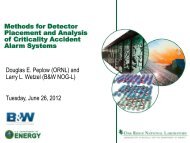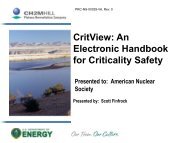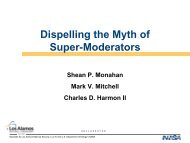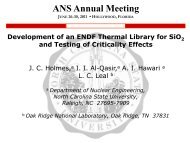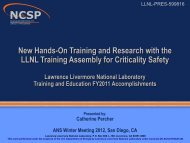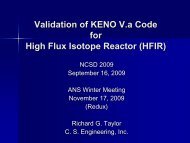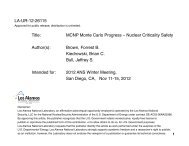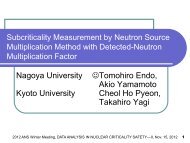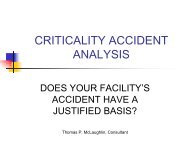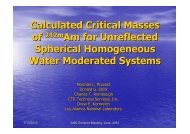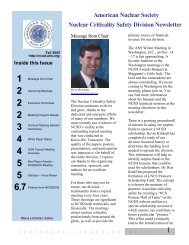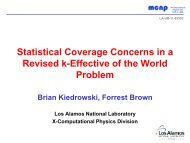A K-25 Love Story?
A K-25 Love Story?
A K-25 Love Story?
- No tags were found...
Create successful ePaper yourself
Turn your PDF publications into a flip-book with our unique Google optimized e-Paper software.
Criticality Safety and NonDestructive Assay ‘A K-<strong>25</strong><strong>Love</strong> <strong>Story</strong>?’Roger W. Bartholomay(URS-Professional Solutions)&Dr. Brandon P. Rasmussen(Restoration Services Incorporated)URS Professional Solutions
INTRODUCTIONFour specific situations will be discussedSurge TanksG-17 ValvesLine Recorder Manifold CabinetsOperations Floor Level Evacuation LineReasons for the need of new or additionalNDA varied depending upon the situationAs a result the plan for NDA measurements variedOutcome, results, and benefits to the K-<strong>25</strong>D&D Project will be discussedURS Professional Solutions2
Surge TanksURS Professional Solutions3
Surge TanksData Between 4 and 8 foot diameter tanks 15 to 26 feet long 1980s neutron and gamma based NDA results indicated 17tanks ranging from ~350 g to ~9,000 g 235 U Most of them were dry, before and during planned movement,but 3 smaller diameter tanks contained Millers FluorinatedLubricantProblem 12 of the tanks would be single parameter type operationsthroughout the lifetime of activities Single parameter type operations involves more controls at boththe Criticality Safety level and at the Technical SafetyRequirements level: → more cost longer schedule forcompletionURS Professional Solutions4
Surge Tank Being MovedURS Professional Solutions5
Surge Tank PlanNDA group provide contemporary measurementresults for each tank Used visual inspection results to more accurately model theconfiguration of deposition within a tank High purity Germanium (HpGe) detector with the In-Situ ObjectCounting System (ISOCS)NCS revise analysis to account for contemporaryNDA When dealing with an individual tank where the inventory ofuranium can not possibly change, additional NDA results can beused to lower the mass upset levels evaluated SCALE and MCNP models were used to specifically determinecritical configurations for tank movementURS Professional Solutions6
Surge Tank ResultsFor smaller diameter surge tanks the contemporary NDA results at +2σaveraged over 1000 g less than historical 1980s NDA resultsFor the bounding large diameter surge tank, the contemporary NDAallowed the normal condition 235 U mass to drop by 2300 gThe NCSE for movement of the surge tanks was revisedFor 5 of the 17 tanks a criticality accident was shown to be incredible during movementOnly 8 of the 17 tanks could not be shown to comply with the DOE requirementspertaining to the Double Contingency Principle (DCP) during movement, all 17 tankscould be shown to comply with DCP during miningThe NCSE for mining (uranium removal) was revisedFor higher mass large diameter tanks, the number of administrative controls wasdecreased by 1/2For lower mass small diameter tanks, the number of administrative controls wasdecreased by 2/3To date, 12 tanks have been mined: contemporary NDA results have provenquite accurateURS Professional Solutions7
G-17 Valve (4 inch diameter)URS Professional Solutions8
G-17 ValvesData~ 5000 G-17 valves existed in K-<strong>25</strong>Range from 3 to 14 inch diameter ProblemEarly ex-situ NDA results on two G-17 valvesrevealed a significant underestimation with existingcharacterization technique (NaI/HMS-4)Issue for both removal and movement of valves aswell as for future criticality incredible determinationsfor those left in the buildingURS Professional Solutions9
G-17 Valve: ProblemURS Professional Solutions10
G-17 Valves: PlanAssemble a team to review the inventory of G-17valvesSelect a representative population to perform in-situmeasurements with HpGe/ISOCS then remove andmeasure in Uranium Neutron Counting System(UNCS)Also analyze with further NDA measurements thetwo upset valves during segmentation and miningUse the results to develop a more conservativeNaI/HMS-4 measurement methodologyURS Professional Solutions11
Uranium Neutron Counting SystemURS Professional Solutions12
G-17 Valves: ResultsAn overhaul of the NaI/HMS-4 measurementmethodology was needed and implementedAll existing HMS-4 results in the CriticalityIncredible Data Management System (CIDMS)were updated with a bias correction factorValves near the EMWMF burial criteria weremeasured a second timeIn the over 3 years since implementation(~2000 valves), no additional cases ofsignificant underestimation with HMS-4 haveoccurredURS Professional Solutions13
Line Recorder Manifold Cabinets (LRMCs)URS Professional Solutions14
Line Recorder Manifold CabinetsProblem 1980s NDA did not characterize Operations floor inaccessible Systematic characterization plan for achieving CriticalityIncredible and burial failed (two LRMCs > 350 g 235 U wereidentified)Plan Remove nearby vent/ductwork in operations floor Build scaffolding from pipe gallery level catwalk Lift HpGe/ISOCS detector up through hole and measure Large Standoffs were combated through longer count times andhelped by low background conditions on operations floorURS Professional Solutions15
Line Recorder Manifold CabinetsURS Professional Solutions16
Line Recorder Manifold CabinetsResultsEach of the Line Recorder Manifold Cabinets weremeasured with qualified NDA instrumentationOnly one exceeded burial ground 235 U mass criteriaEnabled the demolition of the East Wing and NorthEnd of the building to be performed under a criticalityincredible determinationURS Professional Solutions17
UF-6 Evacuation LineURS Professional Solutions18
UF-6 Evacuation LineDescriptionFour inch diameter line between K-1423 and K-27Process knowledge indicates rarely usedNo ties to the K-<strong>25</strong> building process gas systemProblemIt is on the operations floor of East Wing; therefore, inaccessiblesince 2006.No existing characterization to approve it for demolition or forburial at Environmental Management Waste Management Facility(EMWMF)URS Professional Solutions19
UF-6 Evacuation LinePlanGoal was to show the pipe contains less than 10 g 235 U per foot of pipe (EMWMFburial criteria for 4 inch diameter pipe)Measure directly each foot outside K-<strong>25</strong> in the tie line areasSet up HpGe/ISOCS at the tops of certain stairwells and measure as much lengthof pipe as can fit in the field of viewUse man lifts from outside the building at various locations to aim HpGe/ISOCS atthe pipeLow background on operations floor level, combined with longer count times wouldhopefully offset some of the large stand-off distances (10 to 50 feet)ResultsApproximately 38% of the length of the pipe in the building was systematicallycharacterized through these methodsEach measurement result indicated the average g/ft of pipe was less than half theEMWMF burial criteriaNCS was able to claim when combined with process knowledge that this pipewould not lead to a criticality during either demolition or disposal at EMWMFURS Professional Solutions20
ConclusionNDA has been a key element ofcharacterization in order to prepareK-<strong>25</strong> for demolition and disposalA number of situations have stretchedNDA techniques outside normal comfortzonesOver 90% of the massive K-<strong>25</strong> Buildinghas been demolished and disposed atEMWMFURS Professional Solutions21




